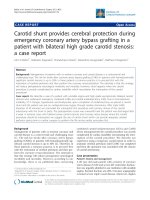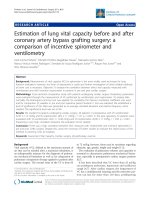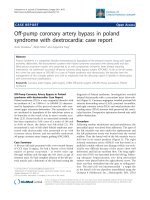Minimally invasive direct coronary artery bypass: preliminary results at University Medical Center of Ho Chi Minh city
Bạn đang xem bản rút gọn của tài liệu. Xem và tải ngay bản đầy đủ của tài liệu tại đây (1.18 MB, 4 trang )
Life Sciences | Medicine
Minimally invasive direct coronary artery bypass:
preliminary results at University Medical Center
of Ho Chi Minh city
Hoang Dinh Nguyen*, Tuan Anh Vo, Thi Thu Trang Nguyen, Tran Viet Chuong Pham, Tam Thien Vu
Department of Cardiovascular surgery - University Medical Center of Ho Chi Minh city
Received 10 October 2017; accepted 12 December 2017
Abstract:
Background - Objectives: In the recent years, minimally invasive direct
coronary artery bypass (MIDCAB) is under rapid development worldwide.
The number of MIDCAB is growing dramatically in developed countries. This
study aimed for the assessment of indications, techniques, and short-term
result of MIDCAB and the experience in building a new technique in our
center.
Method: We reported 4 patients who underwent minimally invasive coronary
artery bypass at the University Medical Center of Ho Chi Minh city.
Results: 4 patients were operated with MIDCAB procedure. Mean ICU time
was 1.4, mean mechanical ventilation time was 5.7 hours, and in-hospital
time was 8.4 days. In postoperative time, patients recovered quickly; they
experienced less pain than normal and returned to normal activities in a short
time.
Conclusions: In our very first experiences with MIDCAB procedure, the early
outcomes are satisfactory with low morbidity and no mortality. MIDCAB is
safe and feasible, provided that patient selection is good and safety protocols
are followed.
Keywords: coronary artery bypass, left minithoracotomy, minimally invasive
cardiac surgery.
Classification number: 3.2
Background
First described in 1910 by Alexis
Carrels, coronary artery bypass grafting
is one of the three major areas of adult
heart surgery. The first selected graft
is the internal thoracic artery. In 1955,
vein grafts were put into use. In 1958,
off-pump coronary surgery was first
performed by Longmire [1].
Coronary artery disease has so far
been widespread, with a long-term
survival of around 77% after 10 years
(Domburg, et al.) [2].
Currently, in Vietnam, coronary
artery bypass surgery has been widely
performed in heart centers. At University
Medical Center of Ho Chi Minh city,
coronary artery bypass surgery has
become a routine surgery.
Technically, this is one of the most
meticulous surgery, requiring the
surgeon to not only have good strategies
and be knowledgeable, but also have
good skills.
The classic opening is the median
sternotomy. Internal thoracic artery,
saphenous vein, gastroepiploic artery
have been used as graft materials. Surgery
is performed with cardiopulmonary
bypass (cardiac arrest) or off-pump
technique (using a specially designed
holder to fix the heart), or under the
support of cardiopulmonary bypass
without cardiac arrest.
The advantage of median sternotomy
is a large surgical field, where the surgeon
can operate easily and conveniently.
However, this approach also has its own
disadvantages.
One of the disadvantages of median
sternotomy is the risk of postoperative
deep sternal wound infection. In coronary
artery bypass surgery via median
sternotomy, there is an increase in the
risk of sternal dehiscence. In addition,
there are general drawbacks such as
postoperative pain, slower recovery than
less invasive surgery, increased hospital
stay, and increased costs [3]. Since the
internal thoracic artery is the first choice
graft, when this artery is harvested,
blood supply to the sternum decreases,
leading to increased risk of infection
and reduced bone healing. From 2005
*Corresponding author: Email:
December 2017 • Vol.59 Number 4
Vietnam Journal of Science,
Technology and Engineering
47
Life Sciences | Medicine
to 2010 in India, Okonta, et al. found
that the mean length of stay for sternal
wound infection was 23.5±8.9 days,
which was much longer than the length
of hospital stay after surgery without
these complications [4].
However, until now, total arterial
coronary artery bypass grafting is still the
gold standard for cases of triple vessels
disease, having the best long-term graft
patency, long-term mortality, as well as
lower incidence of cardiovascular events
than other methods [5].
Currently, triple vessels disease
with stentable lesions in the left
circonflex and right coronary systems
in high-risk patients (elderly, obesity,
diabetes mellitus), median sternotomy
and bilateral internal thoracic arteries
harvesting may increase the postoperative
mortality and complications, particularly
deep sternal wound infection and long
recovery time of the patient. Therefore,
the trend of minimally invasive surgery
has opened a new direction for these
patients: coronary intervention in
combination with surgery.
Method
A total of 4 patients underwent
MIDCAB surgery via left anterior
thoracotomy at the Department of
Cardiovascular surgery of the University
Medical Center of Ho Chi Minh city from
January 2017 to October 2017 (Table 1).
In four patients, there were three
cases of chronic total occlusion of the
Left anterior descending artery (LAD),
one early stent stenosis of LAD in
relatively young patients (54 years),
the patient and his family chose less
invasive coronary artery bypass surgery.
All patients underwent MIDCAB via
left anterior thoracotomy.
Techniques
Patients were placed in supine
position with a cushion under the left
scapula to facilitate exposure; two first
patients were anesthetized with double
lumen endobronchial tube selective left
lung isolation, single lumen endotracheal
tube was used for the following two
patients. An incision of 7 cm was made,
intercostal space was selected depending
on the lesions on the LAD. If lesions of
Fig. 1. Thoragate retractor (left) and surgeon’s position (right).
48
Vietnam Journal of Science,
Technology and Engineering
December 2017 • Vol.59 Number 4
the LAD are at the first or the middle
part, we choose the IV intercostal space
(ICS), if LAD lesions are at the third
part, we choose the fifth ICS (Fig. 1).
A special thoracic retractor (Geister’s
Thoragate) is specially designed to
harvest the left internal mammary
artery (LIMA). The goal is to harvest
to the origin of the artery in order to
avoid stealing blood from the collateral
branches of the internal thoracic artery
to the chest wall. The median duration
of chest harvesting in four patients was
46.5 minutes. The two early patients
were longer than the two following ones.
After being harvested from the chest
wall, the LIMA was cut down to check
the blood flow and ensure no dissection
or damage that affect the flow. The
pericardium was opened at the level of
the LAD. Traction sutures were placed
to give better exposure to this artery. In
the first two cases, we used supported
cardiopulmonary bypass from the
femoral vessels; in the latter two cases,
we performed the complete off-pump
LIMA-LAD anastomosis (Figs. 2, 3).
Life Sciences | Medicine
Table 1. Description of the variables.
Variables
Results
Number of patients
4
Mean ventilation time (hour)
5.7
Mean ICU time (days)
1.4
Mean postoperative time (days)
8.4
After performing the anastomosis,
hemostasis was checked, a chest tube and
a pericardial drainage were placed and the
thoracotomy was closed.
Results and discussions
By the 1980s, coronary artery
bypass surgery had been established as
a widespread and safe surgery. Since the
1990s, less invasive cardiac surgery has
been widely accepted to meet the needs of
patients (less traumatic, cosmetic) and the
requirements of economic benefits (rapid
recovery, reduction in hospitalization
time).
As a result, new surgical instruments
and peripheral cardiopulmonary bypass
techniques have been developed (outside
the thoracic aorta and the vena cava) to
help create a limited access to the surgical
field while maintaining the quality of the
operation.
Minimally invasive cardiac surgery
uses a variety of approaches such as
ministernotomy, minithoracotomy and
small trocar holes (total endoscopic and
robotic surgery). This type of cardiac
surgery reduces bleeding, pain, and the
incidence of surgical site infections.
Additionally, it helps patients recover
quickly, reduces hospital stay, and reduces
medical costs. Many studies have shown
that all of the techniques performed in
cardiac surgery with classic sternotomy
are applicable in less invasive cardiac
surgery without altering the prognosis
of the patient, even when performed for
patients with high surgical risk.
Fig. 2. LAD stent restenosis.
A meta-analysis of P. Modi, et al. from
43 studies published between 1998 and
2005 (two RCTs, 17 case-control studies,
24 cohort studies), found that compared
to
conventional
full
sternotomy,
minimally invasive cardiac surgery did
not increase mortality, and postoperative
cerebrovascular accident. Reoperation
due to bleeding was significantly higher
but tended to decrease with time.
Moreover, infection was significantly
lower (1.8% vs. 7.7%, p = 0.03). The level
of postoperative pain was reduced, and
the recovery time to normal activities was
faster (4 weeks vs. 9 weeks, p = 0.01) [6].
Fig. 3. LIMA harvested (left) and LIMA - LAD anastomosis (right).
In 1998, Duhaylongsod, et al.
described LIMA harvesting through
a small thoracotomy with thoracic
December 2017 • Vol.59 Number 4
Vietnam Journal of Science,
Technology and Engineering
49
Life Sciences | Medicine
endoscopy, which contributed to put the
first steps in minmally invasive coronary
artery bypass surgery [1].
The LIMA - LAD anastomosis has been
shown to have a very good durability in
treating modalities for this very important
coronary artery. If the artery is severly
stenosis and the lesion is complicated,
and unstentable, harvesting the LIMA via
a small thoracotomy with the usage of a
special retractor helps avoid the median
sternotomy. This is especially beneficial
for patients with type 2 diabetes, obesity
as it decreases chest unstability and the
risk of mediastinal infections.
According to Y. Ling, et al.’s report
on minimally invasive coronary artery
bypass surgery, the median duration of
LIMA harvesting was 43 minutes, mean
mechanical ventilation time was 9±7
hours, mean ICU time was 24±18 hours,
the mean units of red blood cell transfused
was 0.79+1.58, and 30 day mortality was
0.5% [7] (Table 2).
R. Birla, et al. conducted a research to
compare the minimally invasive coronary
artery bypass surgery and the conventional
off-pump coronary artery bypass
(OPCAB) grafts on single vessel disease,
which demonstrated no difference in
mortality, recurrent myocardial infarction,
postoperative cerebrovascular accident,
atrial fibrillation, and reoperation [8]
(Tables 3, 4).
At the moment, minimally invasive
coronary artery bypass surgery is
indicated for the following cases:
- Single vessel disease of LAD and/
or diagonal branches with complex,
unstentable lesions.
- Stent restenosis of LAD, unstentable
lesions.
- Three-vessel disease in high-risk
patients, unstentable, revascularisation of
the most important cardiac muscle part
perfused by LAD is indicated.
- Three-vessel disease in high-risk
patients and it is feasible to stent the LCx
and RCA.
- Patients with coronary artery disease
who wish to undergo minimally invasive
surgery on the LAD in combination with
stent placement in the other branches
(right coronary arteries and arteries) [7].
Table 2. In-hospital clinical outcomes and 30-day mortality (N = 200).
MIDCAB (n=138)
Hybrid (n=62)
Total (N=200)
30-day mortality, N (%)
1 (0.7 %)
0 (0.0 %)
1 (0.5 %)
Perioperative MI, N (%)
1 (0.7 %)
0 (0.0 %)
1 (0.5 %)
Duration of mechanical ventilation, hour
9.93±8.65
7.79±4.43
9.27±7.65
LOS in ICU, hour
24.17±17.83
24.48±18.03
24.27±17.85
PRBC, units
0.86±1.63
0.61±1.47
0.79±1.58
PAF, N (%)
10 (7.2 %)
4 (6.5 %)
14 (7.0 %)
Stroke, N (%)
0 (0.0 %)
0 (0.0 %)
0 (0.0 %)
Renal failure, N (%)
0 (0.0 %)
0 (0.0 %)
0 (0.0 %)
Incision complications, N (%)
0 (0.0 %)
0 (0.0 %)
0 (0.0 %)
ICU: intensive care unit; LOS: length of stay; MI: myocardial infarction; PAF: postoperative
atrial fibrillation; PRBC: packed red blood cell.
Table 3. Intensive care unit length of stay for MIDCAB and OPCAB groups.
Length of stay
Ventilation duration
MIDCAB (n=74)
38.36 hours
5.04 hours
OPCAB (n=78)
47.87 hours
5.35 hours
p-value
>0.5
>0.5
Table 4. Comparison of early postoperative outcomes between MIDCAB and
OPCAB groups.
p-value
MIDCAB (n=74)
OPCAB (n=78)
Mortality
0 (0%)
0 (0%)
-
Reoperation for bleeding
0 (0%)
2 (2.7%)
0.2
Atrial fibrillation
17 (22.9%)
12 (15.4%)
0.3
Wound infection
4 (5.4%)
2 (2.7%)
0.4
Cerebrovascular accident
2 (2.7%)
0 (0%)
0.1
50
Vietnam Journal of Science,
Technology and Engineering
December 2017 • Vol.59 Number 4
Collaboration between Cardiac
surgeons
and
Interventional
Cardiologists:
Cardiologists play an important
role in the selection of patients with
minimally invasive coronary artery
bypass surgery based on the indications.
The collaboration between cardiac
surgeons and interventional cardiologists
to select the patient ensures patient safety,
and provides a new option for patients,
especially those at high risk for surgery.
Conclusions
In our very first experiences with
MIDCAB procedure, the early outcomes
are satisfactory with low morbidity and no
mortality. MIDCAB is safe and feasible,
provided that patient selection is good and
safety protocols are followed.
REFERENCES
[1] M. Diodato and E.G. Chedrawy
(2014), “Coronary Artery Bypass Graft Surgery:
The Past, Present, and Future of Myocardial
Revascularisation”, Surgery Research and
Practice, 2014, 6 pp, Article ID 726158.
[2] R.T. Van Domburg, A.P. Kappetein,
A.J. Bogers (2009), “The clinical outcome after
coronary bypass surgery: a 30-year follow-up
study”, European Heart Journal, 30(4), pp.453458.
[3] Jitumoni Baishya, et al. (2017), “Minimally
invasive compared to conventional approach
for coronary artery bypass grafting improves
outcome”, Annals of Cardiac Anaesthesia, 20(1),
pp.57-60.
[4] K.E. Okonta, et al. (2011), “Sternal wound
infection following open heart surgery: appraisal
of incidence, risk factors, changing bacteriologic
pattern and treatment outcome”, Indian Journal
of Thoracic and Cardiovascular Surgery, 27(1),
pp.28-32.
[5] M. Zeriouh, et al. (2017), “Long-term
Survival, Freedom from Re-intervention and Costs
after MIDCAB Compared to PCI on the LAD”, The
Thoracic and Cardiovascular Surgeon, 65(S 01),
pp.S1-S110.
[6] P. Modi, A. Hassan, W.R. Chitwood
(2008), “Minimally invasive mitral valve
surgery: a systematic review and meta-analysis”,
European Journal of Cardio-Thoracic Surgery,
34(5), pp.943-952.
[7] Y. Ling, et al. (2016), “Minimally invasive
direct coronary artery bypass grafting with
an improved rib spreader and a new-shaped
cardiac stabilizer: results of 200 consecutive
cases in a single institution”, BMC Cardiovascular
Disorders, 16, p.42.
[8] R. Birla, et al. (2013), “Minimally
invasive direct coronary artery bypass versus
off-pump coronary surgery through sternotomy”,
The Annals of The Royal College of Surgeons of
England, 95(7), pp.481-485.









